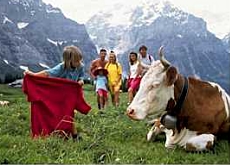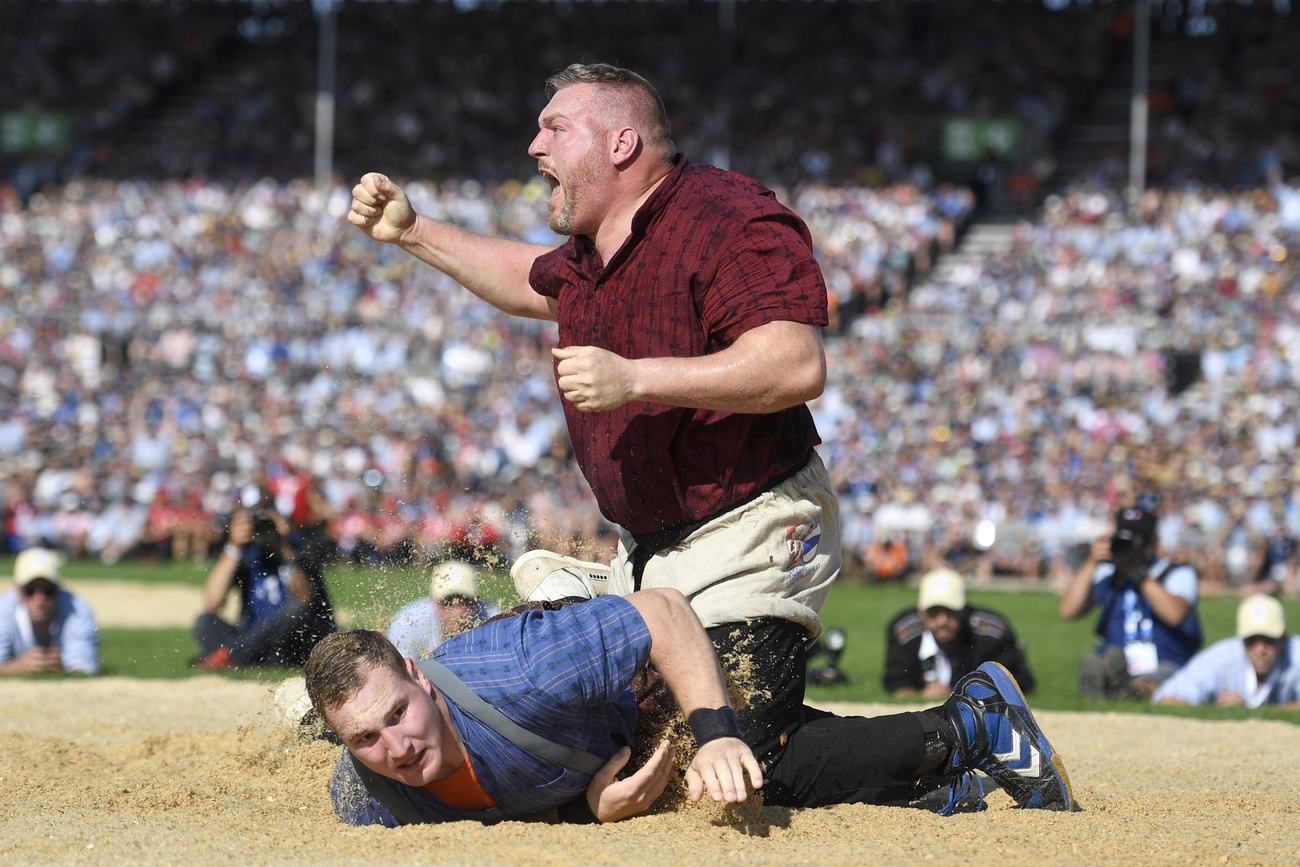
Hikers told how to avoid scuffles with cows

Following numerous reports this summer of "unpleasant encounters between hikers and cattle", the Swiss Hiking Federation has laid down a few ground rules.
The common-sense advice, in the form of cartoons, lists various things walkers should and should not do when strolling through open alpine pastures.
“Do not scare the animals or look them directly in the eye,” the organisation advises. “Do not wave sticks. Never stroke a calf.”
The leaflet appears to be targeted at urban visitors. Most people who live in the countryside would know, for example, that a cow which has lowered its horns in your direction and is scraping the ground isn’t inviting you to pat its head.
Evelyne Zaugg of the Swiss Hiking Federation said that while there were no precise statistics on incidents involving cows, walkers are reporting more run-ins than a few years ago.
“We base our information on press reports,” she told swissinfo. “Part of the problem in compiling statistics is that’s it hard to say when we’re dealing with an accident.”
Walk away
Zaugg said new rearing practices, where animals spend less time around farmers and roam around pastures with little human interaction, were partly to blame for the anti-social behaviour.
Many walkers also panic when confronted by cattle. “Hikers don’t know how to react when a cow appears,” Zaugg said.
The hiking association recommends that if a cow approaches walkers they should remain calm and slowly leave the area without turning their backs on the animal.
“In the event of absolute need,” it advises, “give a precise blow to the muzzle of the cow.”
But managing to punch the animal accurately on the nose is easier said than done – especially when there’s almost a ton of prime beef sitting on you – and as always in animal attacks, absence of body is better than presence of mind.
Zaugg added that cows do not bite, but rather push, pull and lash out. She denied however that cows are naturally aggressive – “they attack because they think their calves are in danger and want to defend them”.
Dog trouble
Michel Darbellay of the Service for the Prevention of Agricultural Accidents, a private organisation that helped produce the leaflet, said walkers had little to fear if they stayed 20-50 metres from any cows.
He also warned that dogs and cows rarely see eye-to-eye.
Last year in canton Graubünden a mother cow took exception to a walker’s dog, and when the woman tried to split up the fight she was flipped down a slope by the cow and badly injured.
Darbellay said it is when the dogs retreat towards their owners that walkers are most likely to face a charging cow. “The best practice is to maintain a fair distance and keep dogs on a leash,” he said.
Zaugg denied that wearing a Swiss flag T-shirt – in effect a red rag with a target on it – increased the chances of being charged by a cow or bull.
“As far as I know the colour isn’t a factor,” she said.
swissinfo, Thomas Stephens
A grown cow can be over 1.5 metre high and weigh up to a ton.
There are more than 1,700,000 head of cattle in Switzerland. The human population is 7.4 million.
The cattle include dairy cows, heifers, calves, bulls, breeding bulls and oxen.
Simmentaler and Brown cows are the most popular breeds in Switzerland.

In compliance with the JTI standards
More: SWI swissinfo.ch certified by the Journalism Trust Initiative
















![The four-metre-long painting "Sonntag der Bergbauern" [Sunday of the Mountain Farmers, 1923-24/26] had to be removed by a crane from the German Chancellery in Berlin for the exhibition in Bern.](https://www.swissinfo.ch/content/wp-content/uploads/sites/13/2025/12/01_Pressebild_KirchnerxKirchner.jpg?ver=bb19e376)















You can find an overview of ongoing debates with our journalists here . Please join us!
If you want to start a conversation about a topic raised in this article or want to report factual errors, email us at english@swissinfo.ch.